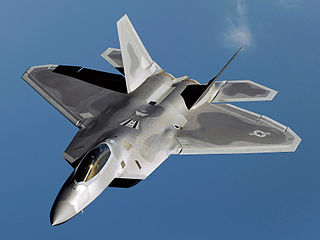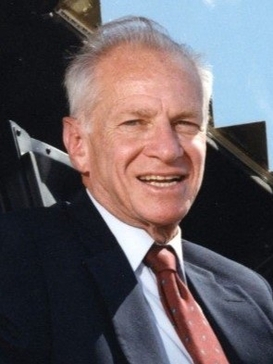
The Lockheed F-117 Nighthawk is a retired American single-seat, subsonic twin-engine stealth attack aircraft developed by Lockheed's secretive Skunk Works division and operated by the United States Air Force (USAF). It was the first operational aircraft to be designed with stealth technology.

The Lockheed Martin F-35 Lightning II is an American family of single-seat, single-engine, all-weather stealth multirole combat aircraft that is intended to perform both air superiority and strike missions. It is also able to provide electronic warfare and intelligence, surveillance, and reconnaissance capabilities. Lockheed Martin is the prime F-35 contractor, with principal partners Northrop Grumman and BAE Systems. The aircraft has three main variants: the conventional takeoff and landing (CTOL) F-35A, the short take-off and vertical-landing (STOVL) F-35B, and the carrier-based (CV/CATOBAR) F-35C.

The Lockheed Corporation was an American aerospace manufacturer. Lockheed was founded in 1926 and merged in 1995 with Martin Marietta to form Lockheed Martin. Its founder, Allan Lockheed, had earlier founded the similarly named but otherwise-unrelated Loughead Aircraft Manufacturing Company, which was operational from 1912 to 1920.

The Lockheed Martin F-22 Raptor is an American single-seat, twin-engine, supersonic all-weather tactical stealth fighter aircraft developed for the United States Air Force (USAF). As a product of the USAF's Advanced Tactical Fighter (ATF) program the aircraft was designed as an air superiority fighter, but also incorporates ground attack, electronic warfare, and signals intelligence capabilities. The prime contractor, Lockheed Martin, built most of the F-22's airframe and weapons systems and conducted final assembly, while Boeing provided the wings, aft fuselage, avionics integration, and training systems.

Stealth aircraft are designed to avoid detection using a variety of technologies that reduce reflection/emission of radar, infrared, visible light, radio frequency (RF) spectrum, and audio, collectively known as stealth technology. The F-117 Nighthawk was the first operational aircraft specifically designed around stealth technology. Other examples of stealth aircraft include the B-2 Spirit, the B-21 Raider, the F-22 Raptor, the F-35 Lightning II, the Chengdu J-20, and the Sukhoi Su-57.

The Boeing X-32 is a concept demonstrator aircraft that was designed for the Joint Strike Fighter competition. It lost to the Lockheed Martin X-35 demonstrator, which was further developed into the Lockheed Martin F-35 Lightning II.

The Lockheed/Boeing/General Dynamics YF-22 is an American single-seat, twin-engine fighter aircraft technology demonstrator designed for the United States Air Force (USAF). The design was a finalist in the USAF's Advanced Tactical Fighter competition, and two prototypes were built for the demonstration/validation phase of the competition. The YF-22 won the contest against the Northrop YF-23, and entered production as the Lockheed Martin F-22 Raptor. The YF-22 has a similar aerodynamic layout and configuration as the F-22, but with differences in the position and design of the cockpit, tail fins and wings, and in internal structural layout.

Lockheed Have Blue was the code name for Lockheed's proof of concept demonstrator for a stealth bomber. Have Blue was designed by Lockheed's Skunk Works division, and tested at Groom Lake, Nevada. The Have Blue was the first fixed-wing aircraft whose external shape was defined by radar engineering rather than by aerospace engineering. The aircraft's faceted shape was designed to deflect electromagnetic waves in directions other than that of the originating radar emitter, greatly reducing its radar cross-section.

Benjamin Robert Rich was an American engineer and the second Director of Lockheed's Skunk Works from 1975 to 1991, succeeding its founder, Kelly Johnson. Regarded as the "father of stealth", Rich was responsible for leading the development of the F-117, the first production stealth aircraft. He also worked on the F-104, U-2, A-12, SR-71, and F-22, among others.

The Australian International Airshow, also called the Avalon Airshow, is a large air show held biennially at Avalon Airport, between Melbourne and Geelong in Victoria.
Bill Sweetman is a former editor for Jane's and currently an editor for Aviation Week group. He is a writer of more than 50 books on military aircraft. He lives in Oakdale, Minnesota. He is noted for his dogged pursuit of the Aurora project. He appeared as an Aerospace Consultant on in the Nova PBS TV program "Battle of the X-Planes" about the Joint Strike Fighter Program.

Joint Strike Fighter (JSF) is a development and acquisition program intended to replace a wide range of existing fighter, strike, and ground attack aircraft for the United States, the United Kingdom, Italy, Canada, Australia, the Netherlands, Denmark, Norway, and formerly Turkey. After a competition between the Boeing X-32 and the Lockheed Martin X-35, a final design was chosen based on the X-35. This is the F-35 Lightning II, which will replace various tactical aircraft, including the US F-16, A-10, F/A-18A-D, AV-8B, EA-6B and British Harrier GR7, GR9s and Tornado GR4. The projected average annual cost of this program is $12.5 billion with an estimated program life-cycle cost of $1.1 trillion.

The 164th Airlift Wing is a unit of the Tennessee Air National Guard, stationed at Memphis Air National Guard Base, Tennessee. If activated to federal service in the United States Air Force, the 164th is gained by Air Mobility Command.

Clarence Leonard "Kelly" Johnson was an American aeronautical and systems engineer. He is recognized for his contributions to a series of important aircraft designs, most notably the Lockheed U-2 and SR-71 Blackbird. Besides the first production aircraft to exceed Mach 3, he also produced the first fighter capable of Mach 2, the United States' first operational jet fighter, as well as the first fighter to exceed 400 mph, and many other contributions to various aircraft.

James E. Brown III is an aerospace executive, test pilot instructor, and former United States Air Force officer. As of 2021, he is the president of the National Test Pilot School located in Mojave, California.
Richard C. Scherrer (1919–2018) was an aircraft designer notable for pioneering work on revolutionary aircraft designs with extremely low radar cross sections that led to the Lockheed F-117 Nighthawk and Northrop Grumman B-2 Spirit.

Air Force Plant 4 is a government-owned, contractor-operated aerospace facility in Fort Worth, Texas, currently owned by the U.S. Air Force and operated by Lockheed Martin Aeronautics. It is home to the F-16 and F-35 fighter aircraft. Military aircraft have been manufactured at the plant since 1942. Plant 4 is adjacent to Naval Air Station Joint Reserve Base Fort Worth, formerly Carswell Air Force Base.

The 924th Fighter Group is a group of the United States Air Force Reserve. It assigned to the Tenth Air Force and stationed at Davis-Monthan Air Force Base, Arizona as a Geographically Separated Unit (GSU) of the Air Force Reserve Command's 442d Fighter Wing at Whiteman Air Force Base, Missouri. On 1 October 2012, the 924 FG was reassigned to the 944th Fighter Wing at Luke Air Force Base, Arizona. The 924th flies the A-10 Thunderbolt II aircraft.

United States Air Force Plant 42 is a classified aircraft manufacturing plant owned by the United States Air Force in the Antelope Valley, about 60 miles from downtown Los Angeles. It is also used by the National Aeronautics and Space Administration (NASA).

























